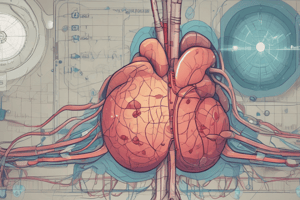Podcast
Questions and Answers
What is the range of systolic arterial pressure at which RBF remains stable?
What is the range of systolic arterial pressure at which RBF remains stable?
- 90 to 180 mmHg (correct)
- 80 to 150 mmHg
- 60 to 120 mmHg
- 100 to 200 mmHg
What is the primary function of the autoregulation mechanism in the kidneys?
What is the primary function of the autoregulation mechanism in the kidneys?
- To increase blood pressure
- To maintain delivery of oxygen and nutrients at a normal level (correct)
- To decrease RBF
- To increase GFR
What happens to the afferent arterioles when systemic blood pressure increases?
What happens to the afferent arterioles when systemic blood pressure increases?
- They are obliterated
- They dilate
- They remain the same
- They constrict (correct)
What is the minimum mean arterial pressure required to perfuse vital organs?
What is the minimum mean arterial pressure required to perfuse vital organs?
What is the mechanism by which the kidneys respond to changes in systemic blood pressure?
What is the mechanism by which the kidneys respond to changes in systemic blood pressure?
What is the result of declining systemic blood pressure on the afferent arterioles?
What is the result of declining systemic blood pressure on the afferent arterioles?
What is the effect of Angiotensin II on RBF and GFR?
What is the effect of Angiotensin II on RBF and GFR?
Which of the following hormones causes vasodilatation and increases RBF?
Which of the following hormones causes vasodilatation and increases RBF?
What is the effect of Natriuretic peptides on RBF and GFR?
What is the effect of Natriuretic peptides on RBF and GFR?
Which of the following substances is a potent vasoconstrictor of afferent and efferent arterioles?
Which of the following substances is a potent vasoconstrictor of afferent and efferent arterioles?
What is the effect of ACE inhibitors on GFR?
What is the effect of ACE inhibitors on GFR?
What is the effect of dopamine on RBF and GFR at low doses?
What is the effect of dopamine on RBF and GFR at low doses?
What is the primary function of the juxtaglomerular apparatus in the regulation of GFR?
What is the primary function of the juxtaglomerular apparatus in the regulation of GFR?
What happens to the flow rate in the loop of Henle when there is a decrease in GFR?
What happens to the flow rate in the loop of Henle when there is a decrease in GFR?
What is the effect of an increase in arterial blood pressure on GFR?
What is the effect of an increase in arterial blood pressure on GFR?
What is the role of the sympathetic nervous system in the regulation of RBF and GFR?
What is the role of the sympathetic nervous system in the regulation of RBF and GFR?
What is the purpose of the sympathetic nervous system's control of RBF and GFR during severe acute disturbances?
What is the purpose of the sympathetic nervous system's control of RBF and GFR during severe acute disturbances?
What is the effect of a decrease in sodium chloride delivery to the distal tubule on the afferent arteriole?
What is the effect of a decrease in sodium chloride delivery to the distal tubule on the afferent arteriole?
Flashcards are hidden until you start studying




